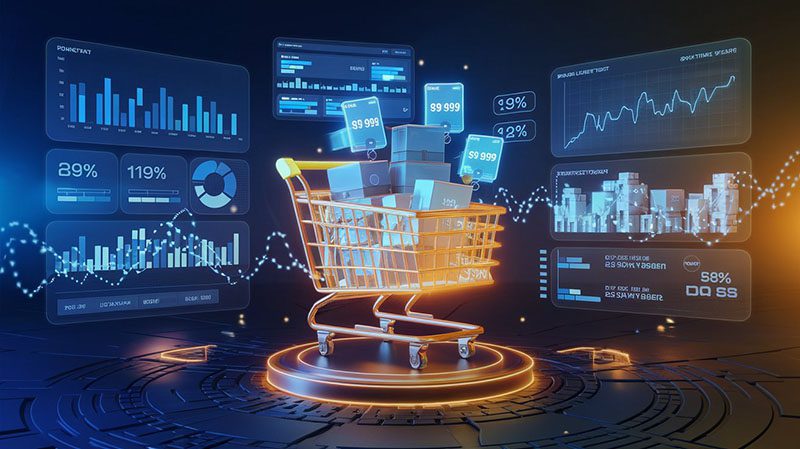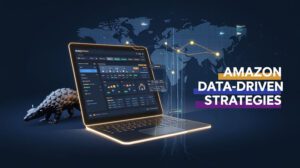When launching a new product on Amazon, one of the most common pitfalls for sellers is “pricing by intuition”—either blindly matching low-priced competitors, which squeezes profit margins, or overconfidently setting the price too high, only to be forced to lower it later due to poor conversion rates.
Pricing is essentially a game, requiring a delicate balance between capturing consumer psychology, market competition, and profit goals. However, many sellers overlook a key fact: pricing is not a one-time decision, but an ongoing dynamic process that needs continuous optimization. This article will dive into the core logic, practical strategies, and data tools for pricing new products on Amazon, helping sellers avoid common traps and use a scientific approach to achieve “pricing equals growth.”
1. Why Can’t New Products on Amazon Be Priced “Off the Cuff”?
1. Price Directly Affects Consumer Decision-Making
Amazon users exhibit highly data-driven behavior patterns. When consumers search for keywords, the platform’s algorithm ranks products based on price, sales volume, review ratings, and other factors. If a new product is priced too high, it may rank poorly due to the lack of historical data; if priced too low, the system may classify it as a “low-value product,” negatively affecting traffic distribution.
For example, a home goods seller launched a smart desk lamp priced at $39.99. Early sales were decent, but the product never broke into the top 50 in BSR. By analyzing competitor data, they found that products priced between $49.99 and $59.99 had higher conversion rates. After adjusting the price to $54.99 and optimizing reviews, their BSR rose to the top 20 within three weeks.
Key Insight: Price is not just a number; it’s a signal for the platform’s algorithm to assess the product’s value.
2. Hidden Costs of Pricing Errors
- Wasted Traffic: The advertising budget for promoting a new product may be inefficiently spent if the price does not match the target audience.
- Brand Damage: Frequent price changes can erode consumer trust, especially among price-sensitive buyers.
- Inventory Risk: Incorrect pricing may lead to unsold stock, forcing sellers to pay long-term storage fees or discount products to clear inventory.
3. The “Price War” Dilemma on Amazon
Many sellers mistakenly believe that “low price = high conversion,” but Amazon’s competitive ecosystem has entered a stage of refined operation.
Case: A seller of electronic accessories priced their new product $5 lower than competitors, leading to a rapid sales increase in the early stages. However, two weeks later, a competitor dropped their price by $8 using coupons, causing the seller’s conversion rate to plummet by 30%. Worse, due to the initial pricing error, the seller was unable to reduce the price further and was eventually forced to exit the market.
Lesson: A pricing strategy without data support is vulnerable to defensive maneuvers.
2. Four Pillars of Scientific Pricing: From Theory to Practice
1. Cost Calculation: The Lifeline of Pricing
Many sellers only calculate the cost of procurement and logistics but overlook the following hidden expenses:
- Amazon Fees: Commission rates vary significantly across categories (e.g., 8% for electronics, 17% for clothing).
- Return Rates: The return rate for apparel can reach 25%, so it’s important to factor in these losses.
- Advertising ACoS: During the initial promotion phase, the ACoS (Advertising Cost of Sale) could be as high as 50%, which should be included in the cost model.
Practical Formula:
Minimum Price = (Cost of Goods + Shipping + Amazon Fees) / (1 – Commission Rate – Expected Profit Margin)
For example, if a product costs $10, shipping is $3, and the Amazon fee is $4.50, with a 15% commission rate and a target profit margin of 20%, the minimum price should be:
(10 + 3 + 4.5) / (1 – 0.15 – 0.2) = $17.5 / 0.65 ≈ $26.92
2. Competitor Analysis: Finding Price “Anchors”
Competitor prices shouldn’t be simply averaged, but rather analyzed in layers:
- Top Competitors: The price range and promotional patterns of the top 10 BSR products.
- Comparable Competitors: Pricing strategies of competitors with similar product features and review scores.
- Substitute Products: Products in different categories that fulfill the same need (e.g., wireless headphones vs. wired headphones).
Key Actions:
- Track competitors’ regular prices, flash sale prices, coupon discounts, and their duration.
- Analyze the correlation between price changes and sales/rankings (e.g., how much did the BSR improve after a competitor reduced their price by $2?).
3. Consumer Psychology: The “Decimal Magic” of Pricing
- Left-Digit Effect: $19.99 is perceived as a “$10 range” product, whereas $20 feels like a “$20 range” product.
- Price Range Sensitivity: For home goods, $25-30 is a sensitive price range, where even a $0.5 difference can impact conversion rates.
- Bundle Pricing: Combine new products with slow-moving items (e.g., a $39.99 main product + $9.99 accessory, bundled at $44.99).
4. Lifecycle Pricing: From Introduction to Maturity
- Introduction: Penetration pricing + high advertising investment to quickly accumulate reviews.
- Growth: Gradually raise the price to market average while focusing on converting traffic.
- Maturity: Increase Average Order Value (AOV) via subscription models and multi-item discounts.
- Decline: Discount clearance while driving traffic to new products.
3. Data-Driven Price Optimization: Why Traditional Methods Fail
Although most sellers acknowledge the importance of data, they still face three major pain points in practice:
1. Data Lag
Manually monitoring competitor prices is time-consuming, and by the time a price change is noticed, the optimal response window may have already passed. For example, a seller of tools lost 40% in orders on a day because they failed to capture a competitor’s limited-time coupon.
2. Fragmented Information
Price data must be analyzed in conjunction with inventory status, review changes, and ad rankings. For instance, a price drop by a competitor could be due to excess inventory or to pre-Prime Day preparations. Isolating price data alone can lead to misinterpretations.
3. Regional Market Differences
The same product may have different pricing strategies across Amazon’s various sites. For example, a baby product might be priced at $49.99 in the US, but due to VAT taxes and logistics costs in Europe, it may need to be adjusted to €54.99 to maintain the same profit margin.
The Breakthrough Key: How to Achieve Real-Time, Accurate Data Insights?
This is where the Pangolin Amazon Scrape API comes into play—it’s not just a data scraping tool but a dynamic pricing decision engine.
1. Functionality Advantages
- Zip Code-based Data Scraping: Accurately identify regional price differences to avoid “piggyback hijacking.”
- Full Data Extraction: Retrieve not only the price but also coupon values, shipping speeds, and inventory statuses (e.g., when a competitor shows “only 3 left in stock,” a price increase may be imminent).
- Historical Price Tracking: Analyze competitor price adjustments, frequency, and their relationship with sales to predict future strategies.
2. Practical Use Cases
- Dynamic Pricing: If a competitor drops their price by 5% in a specific zip code, the system automatically triggers a price adjustment rule.
- Promotion Timing Prediction: Historical data reveals that certain products are discounted 70% of the time during the last week of each month, allowing sellers to stock up early.
- Price Elasticity Testing: During a product launch, set multiple price points ($34.99, $36.99, $38.99) and use A/B testing to quickly find the optimal price range.
3. Differences from Other Tools
Traditional tools like Keepa or Jungle Scout focus on macro trends, while Pangolin stands out with:
- Minute-level Updates: Reacts to flash sales and limited-time coupons in real time.
- Anti-Scraping Mechanism: Uses IP rotation and request frequency control to avoid being banned by Amazon.
- Custom Alerts: Trigger immediate notifications when competitors drop their price below your cost price, preventing destructive competition.
4. Advanced Pricing Strategies: From Survival to Growth
1. The “Leverage Effect” Between Price and Traffic
- Spiral Model: Moderate price increases → higher profits → increased ad spending → higher rankings → organic traffic growth → further price increases.
- Reverse Sniping Strategy: When a competitor raises the price of their flagship product, launch a similar product at 10% lower and capture their customers.
2. Membership Systems and Pricing Synergy
- Prime Exclusive Discounts: Offer hidden discounts to Prime members, boosting conversion rates without affecting public price structures.
- Subscription Save Pricing: Set a single purchase price at $45, subscription price at $38, and use “loss aversion” psychology to encourage long-term repeat purchases.
3. Multi-Dimensional Value Restructuring When products face price saturation, break out of the competition using:
- Service Additions: Offer free engraving or extended warranties (costing an additional $2, priced $15 higher).
- Scenario Bundling: Bundle a sports water bottle with a portable cleaning brush to create a new demand scenario.
- Emotional Premium: Use eco-friendly materials or charity donations as part of the product story to attract high-net-worth customers.
Conclusion: Pricing is a Symbiosis of Science and Art
In Amazon’s data-driven battlefield, pricing has evolved far beyond a simple number game. It’s a complex interplay of consumer psychology, competitive ecosystems, and platform algorithms—and a subtle expression of brand value. True pricing experts use APIs to capture data and human insights to break through the noise.
As the retail adage goes: “There is no wrong price, only wrong perceptions.” When sellers begin to restructure their perceptions using data and tools to enhance efficiency, pricing will become their sharpest growth weapon.
“Don’t ask, ‘How much should I price my product?’ Ask, ‘What value are my customers willing to pay for?’”
(This article is supported by Pangolin Data Engine, with real business cases anonymized.)






